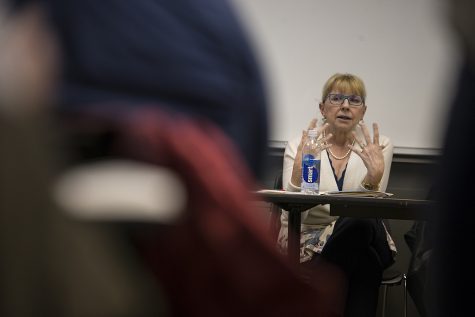Study shows nationwide increase in mental-health treatment among college students
As a recent study by the American Psychiatry Association shows college students are increasingly seeking mental-health treatment, UI officials note that clinical hours for therapy and counseling have risen.
Photo Illustration by Katie Goodale
November 13, 2018
In a recent study, the American Psychiatric Association published findings that show an increase since 2007 in mental-health diagnoses among college students with a simultaneous increase in the number of college students seeking treatment.
The study showed that the number of college students seeking treatment has increased from 19 to 34 percent, among other results. A total of 150,000 students were surveyed on 196 campuses nationwide. The report concluded that those in the field believe the stigma on mental health has eased.
Kelly Clougher, the University of Iowa Counseling Service assistant director for outreach, said its number of clinical hours this semester is higher than in previous years, suggesting an increased number of students seek treatment for a mental-health concern.
“There’s a lot of rhetoric out there saying that this generation of college students doesn’t know how to handle its stress,” Clougher said. “We question that. We think a big part of what’s happening is that students in this generation have a lot of stress to deal with.”
Factors such as the political climate could influence college students’ state of mental health, she said, while the nationwide movement to decrease stigma on mental health may encourage them to seek help.
She emphasized that the primary diagnosis the University Counseling Service witnesses is a mood disorder such as depression or anxiety.
Student Health & Wellness psychiatrist and interim Medical Director Paul Natvig said several of the students who come in for mental-health issues may consequently be struggling with a physical concern as well, such as fatigue or sleep difficulty.
RELATED: UI sees hike in anxiety, depression
“Our psychiatrists and our mental-health physician assistant see full schedules every day,” Natvig said. “We work in coordinating care with primary-care physicians here at [Student Health], our dietitian, and University Counseling Service counselors.”
He outlined the process of a mental-health diagnosis, from the evaluation to treatment, and noted that top conditions usually include anxiety, depression, and ADHD.
“Our visit numbers are up with being fully staffed and adding staff in our psychiatry area, so we are better meeting the increasing demand,” Natvig said. “The stigma of seeking treatment has decreased to some degree.”
Nevertheless, he said, there remains a disproportionate number of people who are hesitant to seek treatment for mental-health issues for reasons such as cultural stigma, a lack of understanding for symptoms and resources, time, or motivation.
Specifically in regards to college students, UI psychiatry Assistant Professor Mark Niciu said difficulties of adjusting to a more independent lifestyle when young adults come to a university could be significant stressors in their lives.
“The first approach is that patients must recognize they are struggling,” Niciu said. “If they don’t seek treatment, the stressors could resolve on their own, best-case scenario. However, untreated illnesses could have a longer course and stronger impact.”
The understanding of the brain and its relation to mental illness is still very rudimentary, he said, but neuroscience techniques are advancing at an extremely rapid rate.
“As we get a better understanding of the brain, we’ll get a better grasp on how we can intervene quickly and make dramatic differences,” Niciu said. “That’s something I’m confident about in the future.”






















